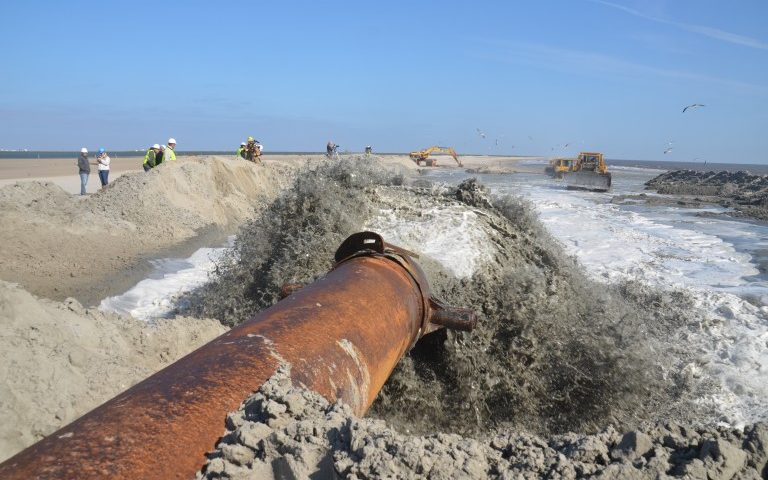By Simone Theriot Maloz, Executive Director, Restore or Retreat, Inc.

Simone Maloz (in white) standing on the newly restored Caminada Headland.
I have always loved the beach, and now, even more so, knowing that the restoration of critical habitat is near complete on the Caminada Headland!
With funding available from criminal fines as a result of the 2010 oil spill, the Caminada Headland Beach and Dune Restoration Project kicked back into high gear in 2015, thanks to over $144 million from the National Fish and Wildlife Foundation (NFWF). The funds, which are on top of the previous $70 million from the State for the first increment already constructed, will go a very long way—over 13 miles to be exact—to making this one of the most beautiful and most important beach habitats along the Gulf Coast.
Over the last 100 years, the Caminada Headland has experienced significant shoreline erosion and land loss, averaging 35 feet per year, to its marsh, wetland, beach and dune habitats as a result of storm overtopping and breaching, saltwater intrusion, wind and wave induced erosion, sea level rise and subsidence.
In total, the Caminada Headlands project aims to create and enhance nearly 800 acres of beach and dune, reinforcing miles of barrier headland habitat, reducing the impacts of storm events on Port Fourchon and Highway 1, a vital hurricane evacuation route for Fourchon and Grand Isle. The Caminada Headland also provides important habitat for nesting shorebirds as well as migratory birds as it is one of the first available stopover sites during migration. The headland is also critical habitat for the endangered Piping Plover.

Aerial view of Caminada Headland restoration. Credit: CPRA
The project—the largest bid out to date by the State’s Coastal Protection and Restoration Authority—has been one both coastal supporters and those in the growing water management industry are watching with keen eyes. This project was also the first time the State tapped into a remnant barrier island 27 miles off the coast of Louisiana, known as Ship Shoal, allowing new material to enter the starved system. The total material placed for the first phase of Caminada alone was 3,633,000 cubic yards of material mined from this abundant coastal resource. The second increment will see an additional five million cubic yards placed on the eastern end of the beach near Elmer’s Island also from Ship Shoal.

Restoration at work on Caminada Headland.
Despite the typical harsh conditions of Louisiana’s shoreline, the first phase of the project has retained over 3.4 million cubic yards of material, or roughly 94 percent. Another three percent is figured to have already landed in Caminada Increment II, thanks to the unique position of the Caminada headland at a nodal zone (an area where currents move sediment both east and west) and the shoreline’s longshore sediment transport pattern.
With the momentum from projects like Caminada and the $110 million Whiskey Island project set to begin in Terrebonne Parish, the future for restoration looks brighter than ever before!

Simone Maloz leading tour of Caminada Headland restoration.
As the executive director of Restore or Retreat, Terrebonne Parish native Simone Maloz works daily to advance projects and policy to address the needs of the disappearing Louisiana coast, specifically across the Barataria and Terrebonne Basins. Ms. Maloz was appointed by Governor Jindal to serve on the Governor’s Advisory Commission on Coastal Protection, Restoration and Conservation in the summer of 2014. She is working with her partners at the Restore the Mississippi River Delta Coalition to ensure Louisiana remains a prosperous place where her children – and their children – can live, work and play.
Enviroshop is maintained by dedicated NetSys Interactive Inc. owners & employees who generously contribute their time to maintenance & editing, web design, custom programming, & website hosting for Enviroshop.
